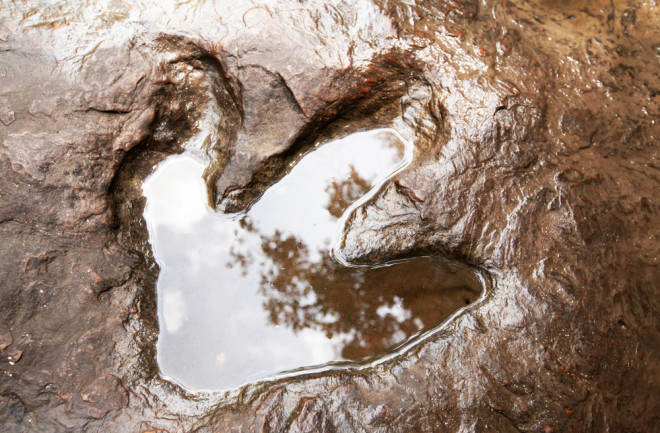Dinosaurs have had an enormous cultural impact, and although they didn’t achieve their fame until the modern age, their footprints may have still captivated curious groups of ancient humans. Recent research at a site in northeast Brazil containing primitive rock art adjacent to dinosaur footprints has revealed how humans interacted with the fossil record in prehistory.
The research, recently published in Scientific Reports, focused on three rock outcrops at the Serrote do Letreiro site in Brazil. The outcrops contained fossilized footprints of theropod, sauropod, and Iguanodontia dinosaurs, all alive during the Early Cretaceous Period. A collection of petroglyphs, or ancient rock art, representing various shapes and motifs were found next to most of the tracks.
What was the Ancient Rock Art?
The majority of petroglyphs were identified on two of the outcrops — labeled outcrops 1 and 3. Based on radiocarbon dating of burial sites in the region, researchers think the petroglyphs could have been carved anywhere from 9,400 to 2,620 years Before Present (BP), although more accurate dating is needed.
The makers of the petroglyphs used tools to scrape the rock’s surface, and they occasionally went through an additional process of “pecking” the surface with tools to create deeper impacts. Their work appears to depict a wide array of motifs, including rectangular grids, circles with radial lines, stars, and a shape with serpentine features.
The researchers say that variations in style among the petroglyphs don’t indicate the work of different human cultures, but rather, represent unique expressions from various individuals within the same group.
They believe that certain petroglyphs convey symbolism, hinting at the cultural significance of fossils for ancient humans. For example, some petroglyphs take the form of a three digit shape that seemingly replicates theropod footprints.
Read More: This Amazon Rock Art Is 12,600 Years Old And Depicts Extinct Creatures
How Ancient Humans Viewed Dinosaur Footprints
The fact that many of the petroglyphs were placed in close proximity to the footprints shows that their creators did acknowledge fossils. None of the petroglyphs interfered with the existing footprints, meaning the creators may have wanted to deliberately avoid damaging the fossils despite not knowing their true origins.
Ancient humans who saw the footprints probably thought they belonged to other animals alive during their time. They may have suspected the theropod tracks came from a rhea, the largest bird in Brazil. Eggshell fragments of rheas have been found at South American archaeological sites dating back to 8,000 years BP.
It is harder to imagine what humans thought of the sauropod tracks since there is no modern Brazilian fauna that has comparable footprints. They may have believed the footprints were from Notiomastodon platensis, an extinct mastodon species that was endemic to South America.
Read More: Human Ancestors Must Have Co-Existed With Dinosaurs
Preserving the Fossil Record
The study stresses the importance of measures that would help preserve the outcrops so that the fossil record in the area can be maintained. Damage from natural forces and human theft threaten the petroglyphs and footprints, so the researchers propose arrangements like handrails for visitors and a structure that can redirect rainwater and prevent debris from moving across the outctops' surfaces.
Protecting the Serrote do Letreiro site, the researchers emphasize, would ensure that the fossils’ cultural influence can live on for years to come.
Read More: What Are Fossils and Where Are They Found the Most?
Article Sources
Our writers at Discovermagazine.com use peer-reviewed studies and high-quality sources for our articles, and our editors review them for accuracy and trustworthiness. Review the sources used below for this article:
Scientific Reports. A remarkable assemblage of petroglyphs and dinosaur footprints in Northeast Brazil.
Britannica. theropod.
Science Direct. Analysis of ancient DNA from South American rhea bones: Implications for zooarchaeology and biogeography.
Britannica. sauropod.

